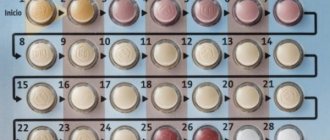One of the most joyful moments in a woman’s life is learning that she is having a child. And if two children are expected, there will be twice as much joy, but also questions. For example, what kind of twins are there or how twins differ from fraternal twins.
In our article you will find answers to these and many other questions, and also learn how fetuses form in different types of multiple pregnancies.
We do not set out to talk about all types of twins - we will talk about the most common ones, that is, fraternal and identical.
Fraternal (dizygotic) twins
Fraternal twins are also called dizygotic, or popularly called fraternal twins. They appear when two eggs are fertilized by two sperm. This happens because the ovaries produce two eggs at a time, rather than one at a time.
Fraternal twins are similar to each other, but no more similar than ordinary siblings—in other words, they are not identical. A fraternal twin pregnancy may result in two boys, two girls, or a boy and a girl. Each fetus has a separate placenta.
Development of individuality in twins
Even if twins are same-sex and similar in appearance, from birth they are two different personalities. The way they are positioned in the womb affects their development. One hears more sounds from the outside world with the right ear, the other with the left, therefore, their brain hemispheres develop differently. One was born first and quickly, but the second had to suffer, therefore, his health is weaker. One way or another, individuality is inherent in every child from birth.
But in our society it is accepted that if twins are twins, then they must be identical from head to toe. They are not only dressed the same, but also forced to eat the same food, follow the same daily routine, and are given the same gifts.
At a very early age, when children are not yet aware of their uniqueness, this is acceptable. But the older the child becomes, the more freedom for the development of his individuality should be provided. Yes, this is much more difficult than “raking both with one brush”, and requires much more time, but parents simply must notice that their children have different inclinations and talents, and are prone to different behavior patterns.
For example, when choosing gifts for twins, parents will most likely buy identical toys, “so that no one will be offended.” But try to look at it from the other side. If you bought one daughter a doll in a pink dress, where is the guarantee that the second daughter will like this same doll?
Try to get creative with this. Let dad go with one daughter to choose a gift at one end of the store, and you go with the second daughter to the other. Give your children the right to choose each other's toys. Let each of the girls think about how she could please her sister? Most likely, children will choose different gifts because they themselves have different personalities. And you must agree that playing with different toys together is much more interesting than playing with the same ones.
While emphasizing the individuality of children, do not forget to develop their independence. After all, the essence of education is also to teach a child to live independently in the adult world. Will a child be able to grow up independent, build his own life and create his own family if he is followed like a shadow by a twin, without whom life is unthinkable?
Try to arrange separate walks and activities for children, and involve your relatives in separate communication with the twins. Take into account the individual abilities of children when creating activities for them.
For example, if one child has stronger artistic abilities, take him to an art gallery. And if the other one has a technical mind, let him and dad try to put together a birdhouse.
Even for a birthday, buy two small cakes with candles, rather than one large one for two. Let each of the twins have their own life experiences, their own personal memories, experiences and dreams.
Identical (monozygotic) twins
Identical, or monozygotic, twins occur when a fertilized egg divides into two fertilized eggs, which develop into two embryos. Such twins are always the same sex, they have the same blood type and the same external characteristics. Identical twins can develop either in the same amniotic sac or in separate ones.
Expectant mothers often ask: “Do identical twins have the same DNA?” In fact, right after birth they have the same DNA, but then they diverge depending on the influence of environmental factors. This is how each twin becomes a unique personality.
To better understand how your babies are developing, we recommend our week-by-week guide for expectant mothers of twins.
Main Differences Between Twins and Twins
In medicine there is no such thing as “twins”, because in a multiple pregnancy three, four, or even five children are born. There is a term for “twins,” which can be identical (monozygotic) or fraternal (dizygotic). These are children who developed in the same womb and were born at the same time. But what kind of children will be born depends on the method of fertilization.
Identical twins are almost indistinguishable from each other in appearance, but fraternal twins can be of different sexes and without obvious external similarity, like brothers and sisters born at different times. Monozygotic twins are closely connected to each other on an emotional level throughout their lives, because they developed from the same egg.
Difference by DNA
Identical or fraternal twins have the same DNA, unlike fraternal siblings. There is a scientific basis for this: each egg and each sperm has unique DNA. Therefore, only half of the genes are the same in fraternal twins. That is, the only thing that distinguishes them from ordinary brothers and sisters is that they were born together.
People born from the same egg are essentially the same, which is why the practice of organ transplantation from one twin to another is successfully widespread in medicine. Also, such brothers and sisters are often diagnosed with the same diseases.
Despite the fact that monozygotic twins have the same DNA, they do not always look identical, because a person’s lifestyle and character also influence their appearance.
There are cases when one mother gave birth to triplets, two of which were identical twins with the same set of genes, and the third child was born from a separate fertilized egg, that is, not identical to the others.
Fertilization
The main difference between identical twins and twins is the fertilization process itself. The former develop from one, divided egg, and the latter - from different ones, fertilized by different sperm.
If at the time of conception two or more eggs are released from the ovary, then they will all be fertilized, since there are millions of sperm. Two embryos are formed in the uterus, with separate aqueous membranes and placentas. People call such relatives “twins.”
Expert opinion
Karnaukh Ekaterina Vladimirovna
Graduated from the National University of Shipbuilding, majoring in Enterprise Economics
It happens that a week after the first egg, which is successfully fertilized, the second one ovulates, into which the sperm also penetrates. Thus, a multiple pregnancy is formed, with one embryo being older than the other. Theoretically, they could even have different fathers.
Identical twins are born from a single egg fertilized by a single sperm. Then the process of division begins and a zygote is formed. Sometimes the zygote begins to divide and two embryos are formed from one cell. Then two identical people with an identical set of genes are born. The exact reasons why identical twins are formed are still not known to science. Sometimes a fertilized cell even divides into 4 parts.
Development in the womb during pregnancy
Identical twins can have a common placenta and amniotic sac, or different ones. The later the zygote divides, the more “close” the children are born. If division occurs in the first three days, then the babies will each have their own placenta and amniotic sac, and if on days 4-8, then the placenta and amniotic sac will be common. When the zygote separates about two weeks after fertilization, there is a high probability of forming “Siamese” twins, fused with body parts. But this is a very rare occurrence, such children are born once in 10 million pregnancies.
Expert opinion
Karnaukh Ekaterina Vladimirovna
Graduated from the National University of Shipbuilding, majoring in Enterprise Economics
It is important to identify a multiple pregnancy in the early stages of pregnancy. Usually it proceeds in the same way as a singleton, but serious complications can occur, for example, fetofetal blood transfusion syndrome, when identical brothers and sisters with a common placenta feed from each other. In this case, one of the fruits may noticeably lag behind in size and development. In a dizygotic pregnancy, the risk of developing malformations in twins is the same as in a singleton pregnancy, and in an identical pregnancy it is 2 times higher.
In the womb, twins constantly interact, the babies touch each other, as if they were touching a reflection in a mirror. It happens that if one of the children is right-handed, then the second is left-handed, moles and birthmarks can also be mirrored in the twins. Most often, boys are born in identical twins.
Appearance mechanism
The birth of identical twins cannot be planned in any way. This is a natural process, a matter of chance. But science knows some factors that contribute to the conception of dizygotic twins:
- At 35-40 years old, the chance of having twins increases. At this age, the hormone responsible for the maturation of eggs accumulates in the female body.
- Heredity.
- An IVF procedure in which the ovaries are stimulated and several embryos are transferred at once.
- Number of pregnancies and births. With each new pregnancy, the chances of conceiving twins increase.
- Cancellation of oral contraceptives. “Rested” ovaries produce eggs with renewed vigor.
- Race – African women are more likely to have twins compared to Asian women.
- Short menstrual cycle (20-22 days).
- Conception during daylight hours. During this period, the hormone gonadotropin is actively produced, which promotes the maturation of eggs. Therefore, during the spring-summer season it is more likely to conceive twins.
- Taking hormonal drugs for infertility.
- Overweight mother.
Out of one hundred multiple pregnancies, only four pairs are identical twins.
By appearance
People born from the same cell are always the same sex and are like two peas in a pod. They have the same facial features, eye color, build, identical, right down to the shape and location of their teeth. Often monozygotic twins are similar in character and temperament. Over time, such siblings may lose some of their similarities due to differences in lifestyle, habits and environment.
Expert opinion
Karnaukh Ekaterina Vladimirovna
Graduated from the National University of Shipbuilding, majoring in Enterprise Economics
In fraternal twins, one child may be completely different from the other. Moreover, often twins are born of different sexes, and the similarities between them are no greater than those of brothers and sisters born at different times. There are cases when twins are born even of different races.
By fingerprints
Identical twins have similar fingerprints, but they have slight differences. The fingerprint match is 95%, although previously it was believed that the patterns on the fingers of the twins matched completely. Twins have different fingerprints.
By blood type
Another difference between twins and twins is their blood type. Identical relatives always have the same blood because they have identical DNA. In the case of dizygotic twins, the blood type may or may not be the same.
Is it true that twins share the same placenta and fetal sac?
Sometimes twins share the same placenta (the organ through which the fetus’s body is connected to the mother’s body), amniotic sac (inner membrane) and chorion (outer membrane); in other cases, each embryo has a separate set of these organs. Consult your doctor - he will tell you how these features may affect your pregnancy and the development of your babies.
Dichorionic diamniotic twins
Such twins have separate chorions and amniotic sacs, as well as a separate placenta for each.
Monochorionic diamniotic twins
Such twins have a common chorion and placenta, and the fetal sacs are separate.
Monochorionic monoamniotic twins
These twins share the same chorion, placenta and amniotic sac. This type is the least common, and it also poses the greatest danger to fetuses, as babies can become entangled in their own umbilical cords. As a rule, the doctor puts expectant mothers with monochorionic monoamniotic twins under special control.
Are twins common?
Recently, due to the emergence of new infertility treatments and the development of IVF technology, multiple pregnancies - twins, triplets, quadruplets, and so on - are becoming more common. In the United States, 3% of all newborns are twins.
The likelihood of having twins is higher in women over 30, if they have a twin sister or brother, or if their maternal relatives have twins.
If you have just found out that you are expecting twins, we recommend that you read materials about the features of multiple pregnancy and what you need to prepare for in this case, and also use a special due date calculator to find out when approximately your babies will be born.
Can a woman have twins during her first birth?
Anything is possible. You remember that multiple pregnancies can be identical or fraternal?
The likelihood of developing identical twins is the same for all women. In both the first and subsequent births, twins of identical babies are born in approximately 4 out of 1000 pregnancies .
Fraternal twins appear for another reason - due to hyperovulation, i.e. the maturation of two or more eggs in one cycle. The following factors influence this:
- use of fertility drugs;
- recent discontinuation of hormonal contraceptives or irregular use of contraceptives;
- obesity , i.e. body mass index above 305;
- genetic predisposition . If you have a twin yourself, if your mother or your sister gave birth to twins, your chances are higher than the average natural probability of having twins;
- height . Tall women are more likely to become mothers of fraternal twins;
- woman's age . The likelihood of multiple pregnancies increases after age 35 7.











